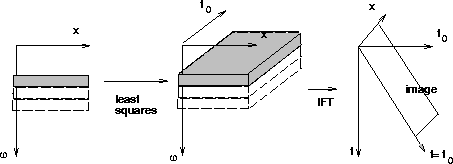




Next: SOLVERS
Up: Cole & Karrenbach: Least-squares
Previous: LEAST-SQUARES SLANT STACK TRANSFORMS
To do least-squares Kirchhoff migration, we either have
to work in the time domain, as is done by Ji elsewhere in
this report, or use time-invariant transforms, despite
their apparent inappropriateness.
A Kirchhoff migration analog to least-squares slant
stacking is summarized in Figure ![[*]](http://sepwww.stanford.edu/latex2html/cross_ref_motif.gif) . Since we
are using time-invariant transforms, a separate least-squares
problem is set up for each frequency. In the slant stack
case, this problem involved transformation to a one-dimensional
space (ray parameter p), since only one parameter is needed
to describe a linear moveout trajectory, its slope.
. Since we
are using time-invariant transforms, a separate least-squares
problem is set up for each frequency. In the slant stack
case, this problem involved transformation to a one-dimensional
space (ray parameter p), since only one parameter is needed
to describe a linear moveout trajectory, its slope.
In the migration case, two parameters are needed to
describe a migration hyperbola: the position
beneath which the apex of the hyperbola lies (x), and
another parameter that describes the curvature of the
hyperbola. If we fix velocity, this second parameter can
be called t0. For a given constant velocity, the hyperbola
will have greater curvature for an early t0, and
less for a later one. The transform space, then, contains
two parameters (x and t0) instead of one in the slant
stack case.
This means that the least-squares problem is likely to be
larger than in the slant-stack case, and is typically
underdetermined. But in principle there is nothing wrong
with the transform space having an extra dimension.
mig
Figure 2 Overview of least-squares migration.
An underdetermined problem is solved for each frequency to find
sources, as a function of x, the position of the hyperbola apex,
and t0, the curvature. The image is contained
in a single plane of the inverse Fourier transformed cube, but
other planes contain information about focusing at other velocities.






Next: SOLVERS
Up: Cole & Karrenbach: Least-squares
Previous: LEAST-SQUARES SLANT STACK TRANSFORMS
Stanford Exploration Project
11/17/1997
![[*]](http://sepwww.stanford.edu/latex2html/cross_ref_motif.gif) . Since we
are using time-invariant transforms, a separate least-squares
problem is set up for each frequency. In the slant stack
case, this problem involved transformation to a one-dimensional
space (ray parameter p), since only one parameter is needed
to describe a linear moveout trajectory, its slope.
. Since we
are using time-invariant transforms, a separate least-squares
problem is set up for each frequency. In the slant stack
case, this problem involved transformation to a one-dimensional
space (ray parameter p), since only one parameter is needed
to describe a linear moveout trajectory, its slope.
